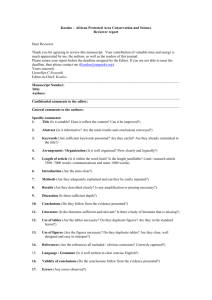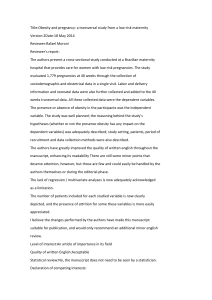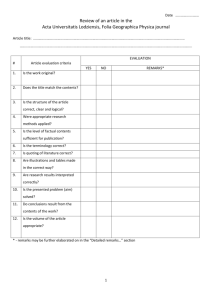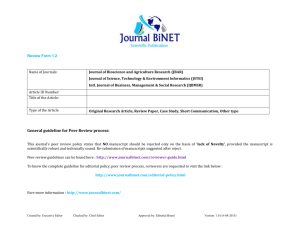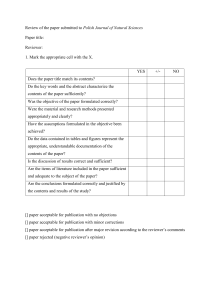11 June 11, 2014 Response to Reviewers Comments Dear Editor
advertisement
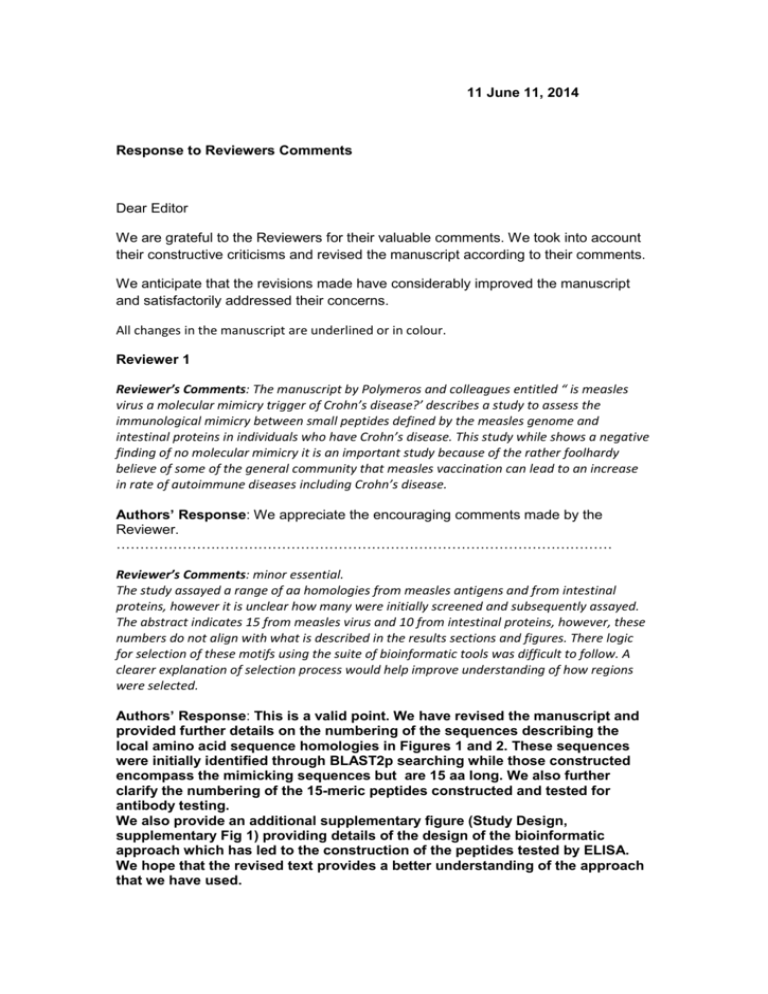
11 June 11, 2014 Response to Reviewers Comments Dear Editor We are grateful to the Reviewers for their valuable comments. We took into account their constructive criticisms and revised the manuscript according to their comments. We anticipate that the revisions made have considerably improved the manuscript and satisfactorily addressed their concerns. All changes in the manuscript are underlined or in colour. Reviewer 1 Reviewer’s Comments: The manuscript by Polymeros and colleagues entitled “ is measles virus a molecular mimicry trigger of Crohn’s disease?’ describes a study to assess the immunological mimicry between small peptides defined by the measles genome and intestinal proteins in individuals who have Crohn’s disease. This study while shows a negative finding of no molecular mimicry it is an important study because of the rather foolhardy believe of some of the general community that measles vaccination can lead to an increase in rate of autoimmune diseases including Crohn’s disease. Authors’ Response: We appreciate the encouraging comments made by the Reviewer. …………………………………………………………………………………………… Reviewer’s Comments: minor essential. The study assayed a range of aa homologies from measles antigens and from intestinal proteins, however it is unclear how many were initially screened and subsequently assayed. The abstract indicates 15 from measles virus and 10 from intestinal proteins, however, these numbers do not align with what is described in the results sections and figures. There logic for selection of these motifs using the suite of bioinformatic tools was difficult to follow. A clearer explanation of selection process would help improve understanding of how regions were selected. Authors’ Response: This is a valid point. We have revised the manuscript and provided further details on the numbering of the sequences describing the local amino acid sequence homologies in Figures 1 and 2. These sequences were initially identified through BLAST2p searching while those constructed encompass the mimicking sequences but are 15 aa long. We also further clarify the numbering of the 15-meric peptides constructed and tested for antibody testing. We also provide an additional supplementary figure (Study Design, supplementary Fig 1) providing details of the design of the bioinformatic approach which has led to the construction of the peptides tested by ELISA. We hope that the revised text provides a better understanding of the approach that we have used. See Results section, Page 17, lines 1-18, From the top See complementary Figure 1 Study Design ………………………………………………………………………………………………………………………………. Reviewer’s Comments: In addition, an explanation of abbreviations used – VGLF, HEMA and MEASA would improve understanding. Authors’ Response: We corrected this in the revised text of the manuscript …………………………………………………………………………………………………………………………………………. Reviewer’s Comments: As a non-measles expert one wonders whether the antigenic regions of measles viruses have been identified using antigenic variant analysis and it would be interesting to know whether the selected peptides actually included these regions as well as those selected purely by bioinformatic programs. Authors’ Response: We appreciate the comments of the Reviewer. In the revised text, in the sections of Methods and Results, as well as in the supplementary Figure 1 Study Design we provide step by step approach of the bioinformatic approach, and the results further analysed, including original number of proteins included in the BLASTp2, the number of pairs obtained and those finally used to design the construction of the peptides. …………………………………………………………………………………….. Comments: The study compared immune responses in a group of sera samples collected from 50 patients with CD, 50 with UC and 38 controls. The small peptides representing the identified protein regions were assayed by an ELISA based assay to compare peptide reactivity across the sera samples. None of the measles/intestinal peptides exhibited a higher immunoreactivity in CD or UC subsets, thus suggesting that no moleculary mimicry was evident. Is the comparison of 50 CD and 38 controls is of sufficient numbers to provide study with good power. Thus a power calculation would help support significance of study. Authors’ Response: We appreciate the comments of the Reviewer. We included a separate section in the results section related to power calculation analyses clearly showing that the number of the sera tested support the significance of the study. Page 16, lines 1-3 from the bottom & Page 17, lines 1-10 from the top …………………………………………………………………………………….. Reviewer’s Comments: discretionary revisions; Pg 11, line 14: delete to complete things. Pg 11, line 17: unsure of why use term “largely”. What are other methods for obtaining protection? Pg 11, line 19: Virtually all vaccine develop… Do authors mean measles vaccines or all vaccines – eg rotavirus, pneumococcal, etc Pg 11, line 20: reword - …those exposed to wildtype measles virus develop antibodies….. Pg 11, line 23: reword - we speculate that measles …. Pg 12, line 9 - replace “tested” with “collected” Pg 13, line 5: reword: were collected. Pg 13, para 3. Should this be in acknowledgements section Pg 13, line 13/14: define HEMA & VGLF Authors’ Response: We appreciate the Reviewer’s revisions and we included those in the revised text. …………………………………………………………………………………….. Reviewer’s Comments: The table detailing patient cohorts is listed as Figure 6. Authors’ Response: We corrected this. …………………………………………………………………………………….. Reviewer’s Comments: Figure 1 & 2 should be infact a single table. Authors’ Response: We agree with the Reviewer that Figures 1 and 2 could be included as a single one. We include the homologies in a Figure rather than as a Table, as this is usually the norm in papers of the same kind. We also subdivided the homologies in two to make it reader’s friendly. Fig 1 includes the homologies involving VGFL MEASE and Fig 2 those involving HEMA MEASE. We leave to the discretion of the editor and the artwork team whether this could be better illustrated in the form of 1 or 2 Figures. …………………………………………………………………………………….. Reviewer’s Comments: Figure 3 is difficult to understand each section and reason for inclusion. For example, reason for inclusion of the entire 617 aa region is unclear, with the second section showing 2 peptide regions. Authors’ Response: We agree with the reviewer that for readers without expertise on bioinformatic approaches these types of figures are not easily understood. We have taken out this Figure and included it as a supplementary Figure. Reviewer’s Comments: Figure 5 is interesting because it highlights the positioning of three of the selected peptide regions on measles virus hemagglutinin. This is a well constructed 3 dimensional prediction, however, given the lack of immune responses one wonders whether this is required. Authors’ Response: We totally agree with the point of the Reviewer. We stressed that the lack of immune responses could be explained by the lack of exposure of the respective sequence at the 3D level, and we attempted to illustrate this in Figure 5. We included this Figure as supplementary Figure, except of the editor’s decision would be to included as a regular one. Reviewer #2 Reviewer’s Comments: Minor essential revisions: Change title to a declarative statement, such as "Bioinformatic and experimental analysis reveals lack of support for measles mimicry in Crohn's disease" Authors’ Response: We changed the title of the paper in accordance to the comments of the Reviewer. We hope that the revised version satisfactorily addresses the comments of the Reviewers and that the paper is suitable for publication. Yours, Professor Spyros Ladas Professor Dimitrios P. Bogdanos (on behalf of all authors)
